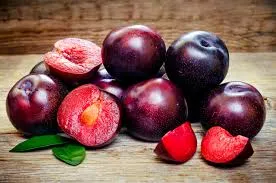Can a Dog Eat Plums? A Comprehensive Guide for Pet Owners
As a devoted pet owner, plums are a popular fruit among humans, but the question remains: Can a dog eat plums? In this article, we will explore the potential benefits and risks associated with feeding plums to dogs, and provide guidance on how to introduce new foods safely.

Understanding Plums
Plums (Prunus domestica) are stone fruits that belong to the genus Prunus, which also includes cherries, apricots, and peaches. These fruits are not only delicious but also packed with nutrients, making them a healthy snack for humans. Plums are rich in vitamins A, C, and K, and they also provide fiber and antioxidants, which can be beneficial for overall health.
Nutritional Benefits of Plums
Before determining if a dog can safely consume plums, let’s take a look at their nutritional profile:
- Vitamins: Plums are an excellent source of vitamin C, which is vital for a healthy immune system, and vitamin K, important for blood clotting and bone health.
- Antioxidants: Plums contain antioxidants, such as phenolic compounds and flavonoids, which help combat oxidative stress in the body.
- Fiber: The fiber found in plums can aid digestion and promote gut health, benefiting both humans and dogs.
Can Dogs Eat Plums?
While plums do contain some beneficial nutrients, it’s essential to approach this fruit with caution. The answer to whether dogs can eat plums is not straightforward, and there are several factors to consider:
1. Toxicity of Plum Pits
The biggest concern regarding dogs and plums is the presence of the pit (or stone) found in the center of the fruit. Here’s why the pit poses a risk:
- Choking Hazard: The plum pit can be a choking hazard for dogs, especially small breeds. Always ensure that the pit is removed before offering any plum to your dog.
- Cyanide Content: Plum pits contain amygdalin, which can release cyanide when metabolized. While a single pit may not cause harm, it’s best to avoid giving your dog any part of the pit.
2. Digestive Issues
Feeding your dog too many plums can lead to digestive problems. The high fiber content can cause gastrointestinal upset, resulting in:
- Vomiting
- Diarrhea
- Abdominal discomfort
If your dog is not used to consuming fruits, it’s essential to introduce plums gradually and in moderation.
3. Sugar Content
Plums are naturally sweet and contain sugars. While these sugars are not harmful in small amounts, excessive sugar intake can lead to:
- Weight Gain: Overindulgence in sugary foods can contribute to obesity, especially in less active dogs.
- Blood Sugar Spikes: Dogs with diabetes or other metabolic issues should avoid high-sugar foods to prevent fluctuations in blood sugar levels.
4. Allergic Reactions
Though uncommon, some dogs may have allergies or sensitivities to plums. Signs of an allergic reaction can include:
- Itching or skin irritations
- Swelling around the face or ears
- Gastrointestinal distress
If you notice any of these symptoms after your dog consumes plums, it’s crucial to consult your veterinarian.
How to Safely Introduce Plums to Your Dog
If you decide to give your dog a taste of plums, it’s essential to do so safely:
- Remove the Pit: Always ensure that the pit is completely removed from the fruit before offering any plum to your dog.
- Start Small: Introduce plums in small amounts to see how your dog reacts. A few small pieces are enough for a first try.
- Monitor Your Dog: Keep an eye on your dog for any signs of digestive upset or allergic reactions after eating plums.
- Consult Your Veterinarian: If you have any concerns about feeding plums to your dog, it’s always a good idea to consult your veterinarian for personalized advice.
What to Do If Your Dog Eats a Plum Pit
If your dog accidentally consumes a plum pit, here are the steps to take:
- Stay Calm: While it can be concerning, many dogs can pass a pit without any problems.
- Monitor for Symptoms: Watch for signs of choking, digestive upset, or unusual behavior. Symptoms to look out for include vomiting, lethargy, or difficulty breathing.
- Consult Your Veterinarian: If your dog shows any concerning symptoms or if you are unsure about the amount consumed, contact your veterinarian for guidance.
Safe Alternatives to Plums
If you’re looking for dog-friendly fruits that are safer than plums, consider these alternatives:
1. Blueberries
Blueberries are small, nutritious, and safe for dogs to eat. They are packed with antioxidants and vitamins, making them a great snack.
2. Apples
Apples are a crunchy and delicious treat for dogs. Just be sure to remove the seeds and core, as the seeds contain cyanide.
3. Bananas
Bananas are a low-calorie fruit that many dogs enjoy. They provide potassium and vitamin C and can be fed in moderation.
4. Carrots
Carrots are a crunchy and healthy snack that can help keep your dog’s teeth clean. They are low in calories and high in fiber.
5. Watermelon
Seedless watermelon is hydrating and offers vitamins A and C. Just make sure to remove any seeds and rind before sharing it with your dog.
Conclusion: Can a Dog Eat Plums?
In summary, while dogs can technically eat plums, it is crucial to approach this fruit with caution. The risks associated with plum pits, potential digestive issues, and the fruit’s sugar content make it less than ideal for canine consumption. If you do choose to share plums with your dog, ensure that the pit is removed, and always introduce new foods gradually and in moderation.
By prioritizing your dog’s health and safety, you can make informed decisions about their diet. Always consult your veterinarian for personalized advice regarding your dog’s dietary needs, and consider offering safer fruit alternatives to keep your furry friend happy and healthy.
